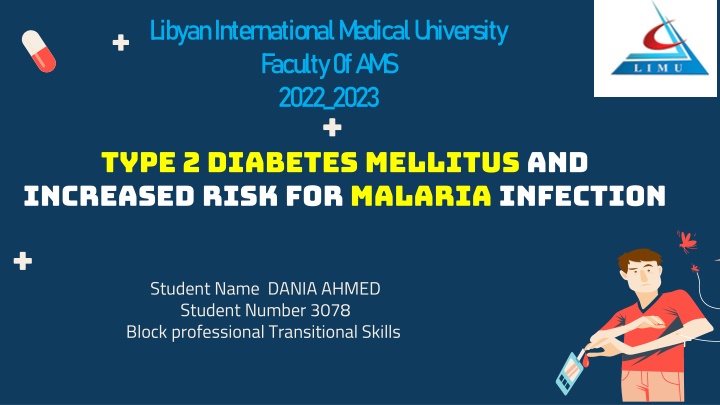
Diabetes and Malaria: Understanding the Connection
Explore the relationship between diabetes and malaria, two prevalent health challenges in the developing world. Learn about atypical presentations of malaria in diabetic patients, the impact on pregnancy, and potential associations between dysglycemia and malaria. Discover the importance of prevention strategies for malaria in individuals with diabetes.
Download Presentation

Please find below an Image/Link to download the presentation.
The content on the website is provided AS IS for your information and personal use only. It may not be sold, licensed, or shared on other websites without obtaining consent from the author. If you encounter any issues during the download, it is possible that the publisher has removed the file from their server.
You are allowed to download the files provided on this website for personal or commercial use, subject to the condition that they are used lawfully. All files are the property of their respective owners.
The content on the website is provided AS IS for your information and personal use only. It may not be sold, licensed, or shared on other websites without obtaining consent from the author.
E N D
Presentation Transcript
L ibyan International M edical U niversity Faculty 0f A M S 2022_2023 Type 2 diabetes mellitus and increased risk for malaria infection Student Name DANIA AHMED Student Number 3078 Block professional Transitional Skills
OBJECTIVEs 02 01 What is the relation between diabetes and malaria Presentation of malaria in dm2 patients 03 Outline The prevention of Malaria
Malaria is a Life-threatening disease caused by parasites that are transmitted to people through the bites of infected female anopheles mosquitoes. It is preventable and Curable
Malaria in the world 2020 2019 The estimated number of Malaria deaths Stood at 627 000 In 2020 an Increase Of 69 000 Deaths Over The Previous Year. While about Two Thirds Of These Deaths (47 000) Were Due To Disruptions During 241 Million Cases Compared To 227 Million Cases The COVID-19 Pandemic.
The relation between Diabetes and Malaria
The relation between Diabetes and Malaria Both malaria and Diabetes are More Common in The Developing World, and Are Major Public Health Challenges. A Direct Relationship Between These 2 Conditions Has Not Been Evaluated
The relation between Diabetes and Malaria Malaria Has been documented to be more common in Diabetes, in Several Studies From Africa. Malarial infection During Pregnancy is an Important Cause Of Low Birth Weight and Anemia and May Contribute To the Intra-Uterine Hypothesis
The relation between Diabetes and Malaria Patients with diabetes have atypical malaria presentations. Glucose-6-phosphate dehydrogenase deficiency, which is associated with primaquine failure for radical cure is also associated with dysglycaemia
02 Presentation of malaria in dm2 patients
Presentation of malaria in dm2 patients Even a lower Parasitic Count Can Lead To Severe manifestations of malaria in people with Diabetes. Relative Bradycardia and Ketoacidosis Were More Frequent in Diabetes , while black water fever and Hypoglycaemia Were Encountered more Often in non-Diabetes Controls Blood urea , Serum Creatinine and Bilirubin Were Sgnificantly HIgher in Dabetics , Haematocrit was higher in diabetics , while parasite count was significantly lower
Case study In sub-Saharan Africa, Infectious Diseases Remain The Predominant Cause Of Illness and Death .. Faces The World s Highest Increase In Type 2 Diabetes Mellitus 1.466 Urban Adult in Ghana Founded That Patients With DM2 46% Increased Risk For Infection With Plasmodium
Case study People With diabetes may be More susceptible to infection with malaria. There have also been studies done show that persons with diabetes may be Actually smell different to mosquitoes than people without dabetes, Malaria transmission is patchy In The Area Where they did the study, for example it May have been coincidence that more people with diabetes lived in high Transmission Neighborhoods than people without diabetes
03 Discuses the prevention of malaria
DISCUSIS THE PREVENTION OF MALARIA The ABCD approach could save your life! Awareness of the risk Bite prevention Chemoprophylaxis Diagnosis
CONCLUSIONS The actual reasons for the increase p. falciparum infection are unclear, the risk increase with rising glucose concentration is a Sign 0f Biological Plausibility , Increased glucose availability may feed p. falciparum
references Eurosurveillance editorial team, C., 2016. WHO launches World health report 2013. Eurosurveillance, 18(33). Christensen, D., Kapur, A. and Bygbjerg, I., 2012. Physiological adaption to maternal malaria and other adverse exposure: Low birth weight, functional capacity, and possible metabolic disease in adult life. International Journal of Gynecology & Obstetrics, 115, pp.S16-S19. Mohapatra, M., Bariha, P. and Mohapatra, A., 2019. Adrenal Insufficiency in Severe Falciparum Malaria: Its Outcome and Prediction by Discriminant Score. International Journal of Contemporary Medical Research [IJCMR], 6(9).
Thank you Thank you






















